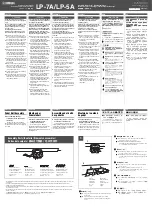
the setting is then most easily made by observing the relevant limiter meter and
setting the hold control so that the meter reads the desired number of decibels of
compression or limiting. If it is found necessary to alter the hold control during a
take, the calibration on the panel will be found useful but it is not as precise as the
meter reading. When the compressor/limiters are ganged only the left hand hold
control functions.
Connection is made to both the meters through a 7-way chassis mounting
socket on the rear of the cassette and a mating plug on a flying lead from the meter
box of the console. The socket also has the +20V, 0V and –20 V lines connected to
socket pins 3, 4 and 5 respectively for test purposes.
3.5.3 Inject
Although the mixer is intended to be completely self-contained with all normal
facilities, occasions may arise when, to produce some unusual effect, it is necessary
to introduce some other device. For this purpose an inject socket for each channel
is provided on the underside of the chassis. For normal operation this must be
provided with a plug with pins 1 and 2 shorted together. The external device must
be connected through an injection unit, which complies with the specification given
in 12.30. This requires the provision of input and output transformers to maintain r.f.
rejection and to remove the possibility of earth loops.
3.5.4 Presence Controls
The circuit of these is described in 12.1. Each channel has two controls.
One of these is marked dB Presence and provides 0, 2, 4, 6, 8 or 10dB boost or cut
at the frequency selected by the other, which is marked kHz Presence. The
frequencies available are 0.5, 0.8, 1.2, 1.8, 2.8, 4.2, 6.5 and 10kHz. The curves
obtained in the
±
10dB conditions are shown on Drawing No. 376.
3.5.5 Bass Control
This provides a flat position and five 2dB steps of lift or cut. Although it is
called a bass control, the frequency of half lift or cut is actually 500Hz. The
frequency response obtained at the various settings is shown in Drawing No. 375.
The circuit is described in 12.2. Since the circuit has no output capacitor, a 6.8
µ
F
capacitor is provided externally with 150k
Ω
to the 0 V line to prevent a large plop
when the fader is inserted.
3.5.6 Fader
This follows the bass control and is a quadrant type instrument, in which the
control enters through a bearing near the bottom, thereby minimising the entry of
dust. It has two chains of resistors connected in parallel. The sliders are staggered
half a stud and the resistors are such that the instrument provides 30 steps of 0.5dB
followed by a graded law of 26 steps to –64dB and Off. The input resistance is
3.19k
Ω
and, when fed from a low impedance, it gives its indicated voltage loss into
50k
Ω
. Since the fader is designed to feed a 50k
Ω
load, a buffer amplifier is
necessary between it and the following pan pot and echo level controls in parallel.















































